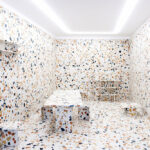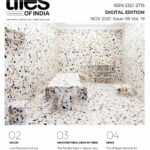ASCER 20th Tile of Spain Awards
Tile of Spain Awards for Architecture and Interior Design have announced the winners!
On 17th November Tile of Spain Awards for Architecture and Interior Design met at ASCER’s headquarters and the panel, presided over by architect Carlos Ferrater (OAB), was made up of the following members: Fermín Vázquez (b270), Jaime Sanahuja (Sanahuja & Partners), José Mª Marzo (Tectónica), Alicia Fernández (Alicia Fernández Interiorismo) and Ángel Pitarch (Castellón Architects’ Association).
The awards had a monetary prize of €15,000 in the architecture category, €15,000 in the interior design category and €5,000 in the end-of-degree project category. The Tile of Spain Awards is sponsored by ICEX, Endesa and the Valencia Port Authority.
The purpose of the Tile of Spain Awards is to raise greater awareness of the use of Spanish tiles in architectural and interior design projects (both in Spain and abroad). The Tile of Spain Awards is a well-established event with a prestigious reputation among professionals from the world of architecture.
The jury reached a unanimous decision to award the following prizes:
The Prize for Architecture:
“The new headquarters of the Valencia Construction Sector Employment Foundation” by MRM Architects’ Studio (Miguel Alonso Flamarique, Roberto Erviti Machain, Mamen Escorihuela Vitales).
The jury praised the use of large-format tiles as a quintessential feature of the building envelope. Likewise, it also commended the use of a standard product, applied in industrial style, to create an outer shell based on the criteria of cleanliness, order and minimum resources.
The new headquarters of the Valencia Construction Sector Employment Foundation is set in rural and semi-industrial surroundings. In keeping with the Valencia region’s physical and cultural backdrop, a decision was taken to use ceramic tiles for the construction and image of the new employment centre, since they are one of the region’s flagship manufacturing products, used extensively there.
The Prize for Interior Design:
“Living in a Coderch” by Estudio Vilablanch
The jury praised the project’s rigorous exercise in interior design, in keeping with the spirit of José Antonio Coderch’s architecture, while highlighting the concept of permanence as a common denominator. It also emphasized the skilful choice of materials and meticulous care with which the design project was put into practice.
The project involved the full refurbishment of an apartment in Barcelona’s emblematic Banco Urquijo building, recapturing the original essence of Coderch’s architecture in contemporary style.
The Prize for the End-of-Degree Project Category:
“Castilla La MaRcha. A resort for Motivated Spain” by Gonzalo López Elorriaga (Madrid School of Architecture)
The jury highlighted the innovative appeal of this provocative project, entitled Castilla la MaRcha, “where ceramic tiles play a starring role in a journey from depopulated Spain to an enjoyable Spain”. It involves the creation of a leisure and entertainment resort unlike typical conventional ones, promoting a rural setting in order to revitalize an abandoned space in the town of Peralvillo while also “highlighting its value through an efficient unorthodox programme aimed at generating profits and attracting a new population”. The project uses traditional-format ceramic tiles in groundbreaking new ways.
SPECIAL MENTIONS
Special Mention in the Architecture Category:
“University’s Faculty of Psychology and Speech Therapy” by Llps Architects’ Studio (Eduardo Pérez Gómez and Miguel Ángel Sánchez García)
The jury highlighted the innovative glossy continuous ceramic skin that was developed for the whole building, using round glazed tiles and other smaller ones in the gaps. To facilitate their installation, a mesh-mounted system was used. The layout of the whole building and its cladding overcome possible problems with meeting points, relinquishing the need to cut the tiles or use special tiles.
Special Mentions in the Interior Design Category:
”JM55” by BURR
For its capacity to create vibrant interiors in such a small space, with the rigorous use of a single central tiled feature around which all the other spaces revolve.
“Cal Garrofa” byJulia Tarnawski & Albert Guerra.
In this case, a special note was made of its radical conceptual philosophy, used to revive a traditional looking home, in addition to the heavy use of colour and ceramic tiles to create a space with strong poetic connotations.
Special Mentions in the End-of-Degree Project Category:
“A civic centre and temporary accommodation in La Asunción former factory” by Mariona Dalmau Benavent (La Salle School of Architecture).
The project involved the design of facilities for a neighbourhood with a civic centre and temporary accommodation for evicted families. The jury highlighted the project’s restrained sobriety. The existing building has been surrounded by a series of box-like volumes, distributed in such a way that Cerdà’s original urban grid has been maintained, generating a new model with a permeable layout and façades with a porous visual design. This helps to make the whole ensemble environmentally efficient, with an urban design worthy of admiration.
“Hortus Conclusus” by Teresa Clara Martínez López (Madrid School of Architecture)
The project aims to link Lisbon’s old quarter to San Jorge Castle and to prolong the existing gardens along the bottom of the hillside through a series of platforms on different levels. The jury highlighted the project’s precision and its rich formal outcome, using ceramic tiles to offer a richly expressive, highly creative future vision of the city and its urban fabric.




GIPHY App Key not set. Please check settings